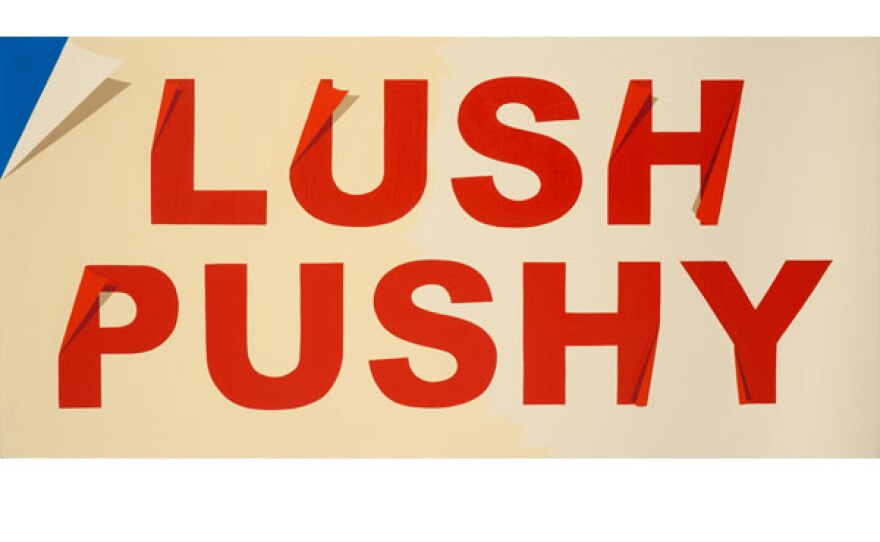Finding meaning in contemporary art often depends more on the viewer than on the artist. What you make of the work is up to you. But what words to use?
An exhibition at the Epsten Gallery explores the intersection between the two – and the open-ended nature of language.
Language as "flexible and hilarious"
Remember palindromes? They're words or phrases that read the same forwards and backwards. Probably the most famous is "Able was I ere I saw Elba," a nod to Napoleon's exile on the island of Elba.
"Early on, I realized I was collecting things that were reversal pairs, like straw and warts, that are palindromatic," says artist Beniah Leuschke. "How I perceive speech has always been this flexible and hilarious thing."
http://youtu.be/Q3_QX4SKnXk
Leuschke describes his multi-media sculptural works as “playing kickball with language.” And when he and Archie Scott Gobber, known for his glossy paintings with well-turned phrases, met as studio neighbors during artist residencies at The Studios Inc. (formerly Review Studios), they recognized kindred spirits.
"We’ve always had kind of a rapport," says Leuschke. "And (we) have been pursuing the same things in very, very different ways."
"We both deal with language, we both deal with conceptual ideas," adds Gobber.
Wit through wordplay
At Wit’s End is the title of their exhibition at the Epsten Gallery at Village Shalom, a white box gallery tucked into a retirement community in Overland Park, Kansas. Gobber says the title’s a wink about being witty through wordplay. And perhaps the undoing of that.
"I think that most people think that language is this absolute thing and it’s not. Words mean many different things and when used in different contexts they change constantly," says Gobber. "We’re just trying to point out...the ridiculous nature of the English language."
http://youtu.be/mlcjLFbofNA
Leuschke and Gobber both graduated from the Kansas City Art Institute, a decade apart. And the two artists have a similar approach; they make lists of ideas, and if they stick, it’s something they pursue. Gobber says when he stretches a canvas, he often doesn’t know what the work is going to be...until he begins. In his painting Revoltion, the word Revolting is centered in the painting in capital red letters.
"You say, you start with the word, rebel, and you’re thinking of rebellion and rebels and things like that. And then, you go, revolt, revolution. Oh, there’s something worth some more time, revolting," explains Gobber. "Just making a painting on revolting operates on so many levels. We’re revolting! Or, that’s disgusting."
Art as dialogue between artist and viewer
Exhibition curator James Martin says he was surprised how much the works related to each other visually when they were installed in the gallery.
"Scott (Gobber) has a piece that looks to be folding in on itself and it’s purposely placed next to Beniah (Leuschke)'s envelope pieces which are all about folding," says Martin. "And on the other wall, we’ve got two pieces: Scott’s God’s Eye painting and Beniah has these conceptual panel pieces based on junk mail. And the color palette for these works is very similar."
Martin, who's also the Curator of the Center for the Healing Arts at Truman Medical Centers, says the meaning of the works is up to the viewer. And as a viewer, he chooses to look for something positive – a theme he explores in his essay for the exhibition. But that can also be a challenge.
"So, I’m basically talking about optimism," says Martin. "Beniah has this piece that has the words, drone strike, so how do you take those two words and come away with something positive from that?"
This piece by Beniah Leuschke called Work Strike, constructed from cut paper, also has the words bar and tender and joy and ride, as well as drone and strike.
"It’s funny, you can be struck in a number of different ways," says Leuschke. "A drone is a genderless insect. A drone can also be a meditative tone."
It’s an ongoing and open-ended dialogue between the artists – and the viewer - both spoken and unspoken.
At Wit's End, through January 6, 2013, at Kansas City Jewish Museum of Contemporary Art's Epsten Gallery at Village Shalom, 5500 West 123rd Street, Overland Park, Kansas, 913-266-8413. Read the online edition of the exhibition brochure here.











